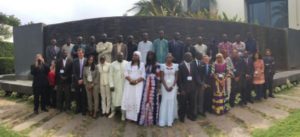Current energy policy is reflected in the Lettre de Développement du Secteur de l’Energie, a government strategy document building on lessons learned from previous energy policies over the period 2005-2012. The emphasis on renewable energy has resulted in the adoption of various legislatures such as the renewable energy law from 2010, which provides for a feed-in tariff. In 2015, the National Agency for Renewable Energies (ANER) was established.
In this context, supported by the U.S. Agency for International Development (USAID), participants representing various agencies within the Senegalese energy sector took part in a four-day workshop on renewable energy project planning and finance. It was conducted by the World Energy Council’s American member committee, the United States Energy Association (USEA), as part of the Power Africa initiative.
Participants ranged from international attorneys, energy investors and engineers to local government officials.
During the workshop participants had the opportunity to exchange best practices with international industry experts on integrating large amounts of variable renewable energy to the grid. Topics discussed include: renewable energy policy implementation, grid management/optimisation for renewables, and best practices for standard Power Purchase Agreements (PPA).
Many audience members also exchanged ideas and feedback on how Senegal can meet its renewable energy targets. The participants also identified areas of collaboration between Senegal and other international utilities on grid integration of renewable energy.
The principles of wind/solar projects, renewable energy grid integration studies and role in planning, risk assessment and determination, practices to increase balancing resources (flexible generation, storage, and demand response), implementation of a public-private partnership projects, and power purchase agreements and negotiations, were some of the topics discussed by Senelec, Ministry of Energy Rural Electrification Agency and the Ministry of Energy.
Audience members expressed a desire to learn about how to combat intermittency and load shedding. These were two of the biggest concerns as utilities struggle with the combination of managing growing distribution needs and introducing renewable energy to the grid.
Dr. Alma Cota, Project Engineer, from the National Rural Electric Cooperative Association International Ltd., shared some insights from her experience with rural electrification in Liberia. While she addressed the importance of creating budgets around the upfront investment costs – as they are normally higher than conventional energy – she also explained the importance of creating legal institutional frameworks to support renewable energy projects.
International experts from Morocco, Liberia and France presented three different types of case studies during their presentations on implementing wind and solar projects. Mr. Adil Khamis, Strategy & Business Development Director, Nareva Holding, shed light on his experiences on his role in implementing Africa’s largest wind farm to date, Tarfaya Wind Farm (301 MW) in Morocco. Similarly, both Morocco and Senegal have abundant renewable energy resources.
Just as in Senegal, Morocco dealt with some of the same challenges such as: heavy dependence on imports, fragile legal and institutional framework, and an unstable transmission grid. During his case study presentation, he explained the entire process from development and financing to completion, testing, and commissioning. He strongly advised that the utility should require a maintenance clause in all investor contracts once the plant has been commissioned.
The afternoon sessions explored the technical aspects of renewable energy integration
A presentation by Issa Dione, Director of Large Generation Projects, Senelec reported that the technical and non-technical electricity losses amount to about 485 GAWh or 20% of the energy passing through the network. He also noted that the production of electricity is 90% hydrocarbons (HFO and diesel).
The significant dependence on biomass, specifically wood and charcoal, has also negatively impacted the country’s economy. With 30% of the generation capacity provided by IPPs, Senelec is aiming to diversity generation with coal-fired and gas base-load to enable broad adoption of renewables.
Key takeaways of the workshop noted by participants included learning more about the environmental benefits of renewable energy integration. They outlined a few challenges such as dealing with Senegal’s large grid and managing demand response, and recommended improving grid flexibility, installing smart meters, and the use of fossil fuels in their baseload.
Another key outcome of the workshop was learning how to better promote more private, public partnerships. The audience sought more information on how to create viable funding mechanisms for financing renewable energy projects.
Some audience members noted that the greatest benefit of the workshop was learning about the importance of independent power producers, particularly in isolated areas.
Additional speakers included Claude Mubaya, Technical Solutions Director, GE Grid Solutions; Adil Khamis, Strategy & Business Development Director, Nareva Holding; Sebastien Wagemans, Sales & Business Development Director, Tractebel Engineering; Gearold Knowles, Partner, Schiff Hardin; and Antoine Haddad from international law firm Allen Overy.






